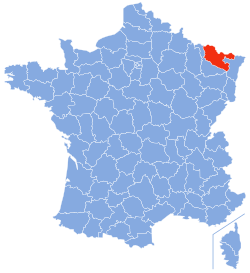Our website is made possible by displaying online advertisements to our visitors.
Please consider supporting us by disabling your ad blocker.
Moselle (department)
You can help expand this article with text translated from the corresponding article in French. (December 2008) Click [show] for important translation instructions.
|
Moselle | |
|---|---|
 Prefecture building of the Moselle department, in Metz | |
 Location of Moselle in France | |
| Coordinates: 49°02′02″N 6°39′43″E / 49.03389°N 6.66194°E | |
| Country | France |
| Region | Grand Est |
| Treaty of Versailles | 28 June 1919 |
| Prefecture | Metz |
| Subprefectures | Forbach Sarrebourg Sarreguemines Thionville |
| Government | |
| • President of the Departmental Council | Patrick Weiten[1] (UDI) |
| Area | |
• Total | 6,216 km2 (2,400 sq mi) |
| Population (2022)[2] | |
• Total | 1,050,721 |
| • Rank | 23rd |
| • Density | 170/km2 (440/sq mi) |
| Time zone | UTC+1 (CET) |
| • Summer (DST) | UTC+2 (CEST) |
| Department number | 57 |
| Arrondissements | 5 |
| Cantons | 27 |
| Communes | 725 |
| ^1 French Land Register data, which exclude estuaries, and lakes, ponds, and glaciers larger than 1 km2 | |
| Part of a series on |
| Lorraine |
|---|
 |
Moselle (French pronunciation: [mɔzɛl] ⓘ) is the most populous department in Lorraine, in the northeast of France, and is named after the river Moselle, a tributary of the Rhine, which flows through the western part of the department. It had a population of 1,046,543 in 2019.[3] Inhabitants of the department are known as Mosellans.
- ^ "Répertoire national des élus: les conseillers départementaux". data.gouv.fr, Plateforme ouverte des données publiques françaises (in French). 4 May 2022.
- ^ "Populations de référence 2022" (in French). The National Institute of Statistics and Economic Studies. 19 December 2024.
- ^ Populations légales 2019: 57 Moselle, INSEE
Previous Page Next Page




